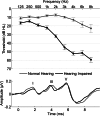Effects of hearing loss on the subcortical representation of speech cues
- PMID: 23654406
- PMCID: PMC3663860
- DOI: 10.1121/1.4799804
Effects of hearing loss on the subcortical representation of speech cues
Abstract
Individuals with sensorineural hearing loss often report frustration with speech being loud but not clear, especially in background noise. Despite advanced digital technology, hearing aid users may resort to removing their hearing aids in noisy environments due to the perception of excessive loudness. In an animal model, sensorineural hearing loss results in greater auditory nerve coding of the stimulus envelope, leading to a relative deficit of stimulus fine structure. Based on the hypothesis that brainstem encoding of the temporal envelope is greater in humans with sensorineural hearing loss, speech-evoked brainstem responses were recorded in normal hearing and hearing impaired age-matched groups of older adults. In the hearing impaired group, there was a disruption in the balance of envelope-to-fine structure representation compared to that of the normal hearing group. This imbalance may underlie the difficulty experienced by individuals with sensorineural hearing loss when trying to understand speech in background noise. This finding advances the understanding of the effects of sensorineural hearing loss on central auditory processing of speech in humans. Moreover, this finding has clinical potential for developing new amplification or implantation technologies, and in developing new training regimens to address this relative deficit of fine structure representation.
Figures



References
Publication types
MeSH terms
Grants and funding
LinkOut - more resources
Full Text Sources
Other Literature Sources

